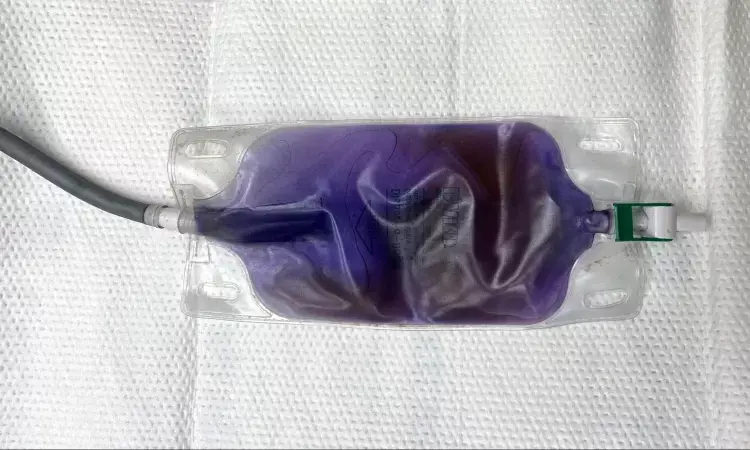- Home
- Medical news & Guidelines
- Anesthesiology
- Cardiology and CTVS
- Critical Care
- Dentistry
- Dermatology
- Diabetes and Endocrinology
- ENT
- Gastroenterology
- Medicine
- Nephrology
- Neurology
- Obstretics-Gynaecology
- Oncology
- Ophthalmology
- Orthopaedics
- Pediatrics-Neonatology
- Psychiatry
- Pulmonology
- Radiology
- Surgery
- Urology
- Laboratory Medicine
- Diet
- Nursing
- Paramedical
- Physiotherapy
- Health news
- Fact Check
- Bone Health Fact Check
- Brain Health Fact Check
- Cancer Related Fact Check
- Child Care Fact Check
- Dental and oral health fact check
- Diabetes and metabolic health fact check
- Diet and Nutrition Fact Check
- Eye and ENT Care Fact Check
- Fitness fact check
- Gut health fact check
- Heart health fact check
- Kidney health fact check
- Medical education fact check
- Men's health fact check
- Respiratory fact check
- Skin and hair care fact check
- Vaccine and Immunization fact check
- Women's health fact check
- AYUSH
- State News
- Andaman and Nicobar Islands
- Andhra Pradesh
- Arunachal Pradesh
- Assam
- Bihar
- Chandigarh
- Chattisgarh
- Dadra and Nagar Haveli
- Daman and Diu
- Delhi
- Goa
- Gujarat
- Haryana
- Himachal Pradesh
- Jammu & Kashmir
- Jharkhand
- Karnataka
- Kerala
- Ladakh
- Lakshadweep
- Madhya Pradesh
- Maharashtra
- Manipur
- Meghalaya
- Mizoram
- Nagaland
- Odisha
- Puducherry
- Punjab
- Rajasthan
- Sikkim
- Tamil Nadu
- Telangana
- Tripura
- Uttar Pradesh
- Uttrakhand
- West Bengal
- Medical Education
- Industry
Elderly Patient Develops Rare Purple Urine Bag Syndrome, Raising Awareness of Catheter-Related Risks: Case Report

Iran: A recent case of purple urine bag syndrome, described in BMC Nephrology, has highlighted the complex interplay between urinary infections and indwelling catheters, raising important management considerations for healthcare providers.
Purple urine bag syndrome (PUBS) is a rare phenomenon that can occur in patients with indwelling bladder catheters, often linked to urinary infections. This unusual condition manifests as a striking purple discoloration in the urine, resulting from metabolic byproducts formed by bacterial enzymes. The process begins when gastrointestinal flora breaks down the amino acid tryptophan into indole, which enters the portal circulation and is converted into indoxyl sulfate. When excreted in the urine, indoxyl sulfate can further break down into indoxyl under alkaline conditions, leading to the formation of the blue and red pigments indigo and indirubin.
The case highlighted the complexities of PUBS in an elderly woman residing in a nursing home. The patient had a history of multiple comorbidities, including a cerebrovascular accident (CVA) and acute kidney injury (AKI). She was admitted to the hospital with decreased consciousness, fever, and kidney failure. On the third day of her hospitalization, she developed PUBS during urinary catheterization. Notably, she had no prior catheterizations or chronic antibiotic use, aside from Tolterodine, which she had been taking for urinary urgency.
Due to antibiotic resistance, the patient's medications remained unchanged; however, the purple discoloration resolved following the catheter and urinary bag replacement. According to Fatemeh Mahdi & Amirhossein Larijani from Guilan University of Medical Sciences, Rasht, Iran, the case marks the first reported instance of this phenomenon in the region.
The authors emphasize the need for advancements in catheter technology and care protocols to minimize catheter-related urinary tract infections (UTIs) and enhance outcomes for patients experiencing Purple Urine Bag Syndrome (PUBS). Collaborative efforts to create comprehensive databases can facilitate the development of effective healthcare strategies and policies. Additionally, long-term studies evaluating the impact of PUBS on patient outcomes and quality of life from a patient-centered perspective are essential.
Understanding the causes, clinical presentation, management strategies, and epidemiology of PUBS is crucial for providing effective care to catheterized patients. This case highlighted key risk factors, including female gender, a history of cerebrovascular accident (CVA), and AKI. Notably, PUBS developed during the first catheterization of the patient, despite no previous catheter use or antibiotic history, and the urine was not alkaline.
The presence of antibiotic resistance—limited to nitrofurantoin—and the resolution of PUBS through catheter change alone, without altering the antibiotic regimen, were particularly noteworthy findings.
"Ongoing research and additional case reports will further enhance our understanding of PUBS and improve outcomes for those affected by this condition," the researchers concluded.
Reference:
Mahdi, F., Larijani, A. Purple urine bag syndrome: a unique clinical case and management considerations. BMC Nephrol 25, 375 (2024). https://doi.org/10.1186/s12882-024-03708-6
Dr Kamal Kant Kohli-MBBS, DTCD- a chest specialist with more than 30 years of practice and a flair for writing clinical articles, Dr Kamal Kant Kohli joined Medical Dialogues as a Chief Editor of Medical News. Besides writing articles, as an editor, he proofreads and verifies all the medical content published on Medical Dialogues including those coming from journals, studies,medical conferences,guidelines etc. Email: drkohli@medicaldialogues.in. Contact no. 011-43720751


